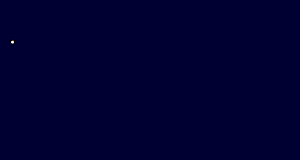
Alien craft or everyday satellite?
How many people have looked up into the night sky and followed the trajectory of a satellite for more than just a few seconds and have, then, reported that it suddenly and instantaneously changed direction. No sweeping turn or gentle curve just an immediate change, sometimes at right angles, and then back onto it's normal trajectory. Clearly this defies all known physics and it's either miraculous, magic or an alien spaceship.
Well, I'm here to say that it's none of the latter.
It is to do with a few idiosyncacies of vision. The eyeball engages in 'saccadic' movements, that is tiny involuntary twitches and when it is pusuing a slow target such as our satellite, these saccadic movements persist when the eye is at rest on a target but appear more pronounced when tracking. Now the light from a satellite is faint and does not saturate the visual cells to the extent that a 'Persistence of Vision' effect actually persists. It only ensues for a few milliseconds. Persistence of Vision is the retention of a visual image for a short period of time after the removal of the stimulus that produced it and occurs under much brighter light and there are few objects in the night sky that qualify. One would normally see trails of light across the retina while tracking a bright object but with our satellite there is nothing. So when we have a saccadic eye movement the satellite appears to have a sudden change of direction. The Persistence of Vision does not last long enough to produce a smooth motion as it would with animation frames for instance. Further voluntary saccades would attempt to restore the target to the foveal centre of vision. Below is something similar in effect.

I wasn't sure where to put this file because it could just as easily come under "Illusions". Perhaps I'll put it there as well.